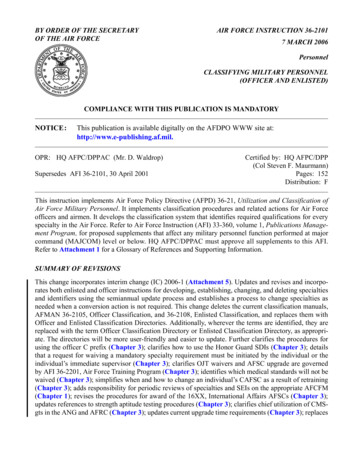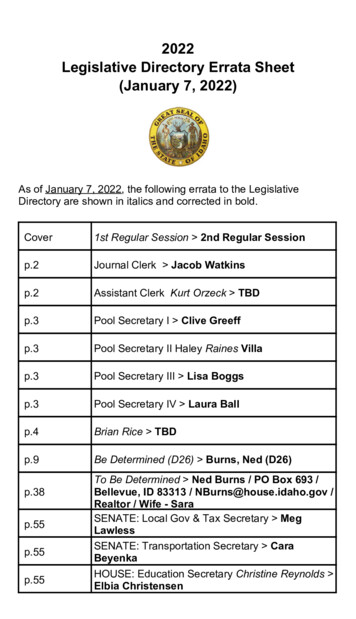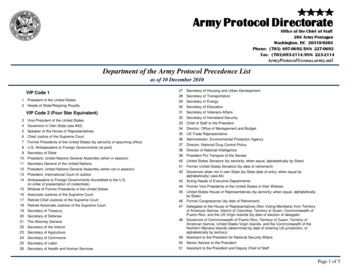
Transcription
BY ORDER OF THE SECRETARYOF THE AIR FORCEAIR FORCE INSTRUCTION 36-21017 MARCH 2006PersonnelCLASSIFYING MILITARY PERSONNEL(OFFICER AND ENLISTED)COMPLIANCE WITH THIS PUBLICATION IS MANDATORYNOTICE:This publication is available digitally on the AFDPO WWW site at:http://www.e-publishing.af.mil.OPR: HQ AFPC/DPPAC (Mr. D. Waldrop)Supersedes AFI 36-2101, 30 April 2001Certified by: HQ AFPC/DPP(Col Steven F. Maurmann)Pages: 152Distribution: FThis instruction implements Air Force Policy Directive (AFPD) 36-21, Utilization and Classification ofAir Force Military Personnel. It implements classification procedures and related actions for Air Forceofficers and airmen. It develops the classification system that identifies required qualifications for everyspecialty in the Air Force. Refer to Air Force Instruction (AFI) 33-360, volume 1, Publications Management Program, for proposed supplements that affect any military personnel function performed at majorcommand (MAJCOM) level or below. HQ AFPC/DPPAC must approve all supplements to this AFI.Refer to Attachment 1 for a Glossary of References and Supporting Information.SUMMARY OF REVISIONSThis change incorporates interim change (IC) 2006-1 (Attachment 5). Updates and revises and incorporates both enlisted and officer instructions for developing, establishing, changing, and deleting specialtiesand identifiers using the semiannual update process and establishes a process to change specialties asneeded when a conversion action is not required. This change deletes the current classification manuals,AFMAN 36-2105, Officer Classification, and 36-2108, Enlisted Classification, and replaces them withOfficer and Enlisted Classification Directories. Additionally, wherever the terms are identified, they arereplaced with the term Officer Classification Directory or Enlisted Classification Directory, as appropriate. The directories will be more user-friendly and easier to update. Further clarifies the procedures forusing the officer C prefix (Chapter 3); clarifies how to use the Honor Guard SDIs (Chapter 3); detailsthat a request for waiving a mandatory specialty requirement must be initiated by the individual or theindividual’s immediate supervisor (Chapter 3); clarifies OJT waivers and AFSC upgrade are governedby AFI 36-2201, Air Force Training Program (Chapter 3); identifies which medical standards will not bewaived (Chapter 3); simplifies when and how to change an individual’s CAFSC as a result of retraining(Chapter 3); adds responsibility for periodic reviews of specialties and SEIs on the appropriate AFCFM(Chapter 1); revises the procedures for award of the 16XX, International Affairs AFSCs (Chapter 3);updates references to strength aptitude testing procedures (Chapter 3); clarifies chief utilization of CMSgts in the ANG and AFRC (Chapter 3); updates current upgrade time requirements (Chapter 3); replaces
2AFI36-2101 7 MARCH 2006Personnel Employment with Unit CSS as the approval authority for most base-level AFSC downgrade orwithdrawal actions (Chapter 4); clarifies when and how ANG and USAFR may supplement classification procedures (Chapter 5); Adds new Chapter 6 to incorporate necessary procedures for updating theclassification system and the directories; and revises list of abbreviations and acronyms (Attachment 1);updates references to 2096 and 623a to Information Management Tools (IMTs); updates addresses of contact points throughout the AFI; updates publication references; updates system terms throughout the AFI;and minor editing and format alterations have also been incorporated into this change. A bar ( ) indicatesa revision from the previous edition.Chapter 1— CLASSIFICATION OBJECTIVE, CONCEPT, TENETS,RESPONSIBILITIES, AND STRUCTURE61.1.Program Objective. .61.2.Classification Concepts and Tenets: .61.3.Program Responsibilities: .71.4.Classification Structure.9Table 1.1.Airman AFSC Explained. .10Table 1.2.Officer AFSC Explained. .11Chapter 2— INITIAL CLASSIFICATION PROCEDURES132.1.Newly Commissioned Officer. .132.2.Classifying Non-Prior Service (NPS) Airmen: .132.3.Classifying Prior Service Enlistees. .142.4.Classifying Former Air Force Officers: .152.5.Strength Aptitude Test (SAT). .162.6.Determining the Initial CAFSC. .16Table 2.1.Initial Determination of CAFSC. .16Chapter 3— CLASSIFICATION ACTIONS AT BASE OF ASSIGNMENT173.1.Designating a Primary Air Force Specialty Code (PAFSC). .173.2.Designating Other AFSCs: .173.3.Designating DAFSC and Reporting Duty Titles. .173.4.Awarding Special Duty Identifiers (SDI). .183.5.Awarding or Designating Reporting Identifiers (RI). .183.6.Reinstating an AFSC, SDI, or RI. .183.7.Waiving Mandatory Requirements. .18
AFI36-2101 7 MARCH 2006Table 3.1.3Waiver Authority for Mandatory Classification Requirements--Officers(see paragraph 3.7.). .20Waiver Authority For Mandatory Classification Requirements--Enlisted Personnel(see paragraph 3.7). .21Table 3.3.Procedures for Processing All Classification Waiver Requests. .233.8.Converting to New or Revised AFSs: .253.9.Changes in Mission, Weapon System, or Equipment. .253.10.Procedures for Using Suffixes. .253.11.Procedures for Using Prefixes. .263.12.Classifying Patients. .263.13.Managing Special Experience Identifiers (SEI): .263.14.Classifying General Officers. .283.15.Awarding Air Force Specialty Codes (AFSC) to Officers. .293.16.Awarding Intermediate or Qualified AFSCs. .293.17.Classifying Commanders. .293.18.Using the Commander Prefix. .293.19.Awarding Medical Utilization Field AFSCs (4XXX). .303.20.Awarding Chaplain Utilization Field AFSCs (52RX). .303.21.Awarding Legal Utilization Field AFSCs (51JX). .303.22.Rated Officers. Loss of Aircraft Qualification. .303.23.Classifying Officers of Other Services Working in the Air Force. .303.24.Competitive Category Transfers. .303.25.Awarding the International Affairs (16FXX) Specialty. .303.26.Awarding AFSCs in Enlisted Career Fields. .313.27.Strength Aptitude. .313.28.Classifying Students. .313.29.Classifying Chapel Management Personnel Except USAFR Airmen. .323.30. Classifying Instrumentalists. .323.31.Classification Interviews and Audits: .323.32.Using Feeder AFSCs. .323.33.Determining CAFSC. .333.34.Use Outside of CAFSC. .33Criteria for Awarding Officer-Rated AFSCs. .35Table 3.2.Table 3.4.
4AFI36-2101 7 MARCH 2006Table 3.5.Criteria for Awarding Officer AFSCs, SDIs and RIs Other Than Rated AFSCs. .36Table 3.6.Classifying Students--Officers. .37Table 3.7.Criteria for Awarding Enlisted AFSCs, SDIs, RIs or CEM Codes. .38Table 3.8.Grade and Skill-Level Authorizations for Use in Establishing Manpower Positions.39Table 3.9.Determining the CAFSC for Enlisted Personnel in Training Status. .40Table 3.10. Determining CAFSC as a Result of Assigning or Withdrawing Awarded CEMs,AFSCs, SDIs, or RIs. .41Chapter 4— DOWNGRADING AND WITHDRAWING AFSC PROCEDURES424.1.Downgrading AFSCs or Withdrawing Awarded AFSCs, CEMs, SDIs, or RIs. .42Table 4.1.Downgrading AFSCs for Lack of Recent Performance (see note). .43Table 4.2.Downgrading AFSCs as a Result of Demotion (see note). .444.2.Officer Disqualification Actions. .474.3.Certifying Intelligence Officers for Security Access (AFSCs 14NX): .474.4.Effective Date of Downgrade or Withdrawal Actions: .48Table 4.3.Procedures for Processing Downgrade and Withdrawal Actions. .49Figure 4.1.Sample Statement To Accompany AFSC Withdrawal Case File. .50Chapter 5— AIR RESERVE FORCES PERSONNEL NOT ON EXTENDED ACTIVEDUTY (EAD)515.1.Classifying Responsibilities: .515.2.Classifying Procedures: .515.3.Awarding AFSCs in the Legal Utilization Field (51JX). .51Chapter 6— AIR FORCE CLASSIFICATION DIRECTORIES(OFFICER AND ENLISTED)6.1.52Using The Air Force Officer and Enlisted Classification Directories(AFOCD/AFECD): .526.2.Describing the Classification Structure. .526.3.Explaining the Enlisted Specialty Description. .536.4.Explaining the Officer Specialty Description. .546.5.Responsibilities: .556.6.Requesting New or Revising Existing Classification: .566.7.Information Collections, Records, and Forms/Information Management Tools(IMTs). .58
AFI36-2101 7 MARCH 20065Attachment 1— GLOSSARY OF REFERENCES AND SUPPORTING INFORMATION60Attachment 2— AFSC DOWNGRADE/WITHDRAWAL/WAIVER PACKAGEGUIDELINES67Attachment 3— IC 99-1 TO AFI 36-2101, CLASSIFYING MILITARY PERSONNEL(OFFICER AND AIRMEN)72Attachment 4— IC 2001-1 TO AFI 36-2101, CLASSIFYING MILITARY PERSONNEL(OFFICER AND ENLISTED)98Attachment 5— AFI 36-2101, CLASSIFYING MILITARY PERSONNEL120
6AFI36-2101 7 MARCH 2006Chapter 1CLASSIFICATION OBJECTIVE, CONCEPT, TENETS, RESPONSIBILITIES,AND STRUCTURE1.1. Program Objective. The objective of the military personnel classification system is to identifyduties and tasks for every position needed to accomplish the Air Force mission. The system is designed toidentify qualifications and abilities necessary to accomplish these duties and tasks, as well as provideclear and visible career progression patterns. It links duties and tasks into cohesive job clusters that areused to match personnel requirements with personal aptitudes, attributes, and qualifications. The classification system also provides concise award, upgrade, and retention criteria for career progression.1.2. Classification Concepts and Tenets:1.2.1. Functional Grouping Concept. The classification system groups related work requirements(positions) into Air Force Specialties (AFS). Positions are grouped on similarity of functions andrequirements for knowledge, education, training, experience, ability, and other common criteria. AFSsare further combined into broader and more general functional categories called career fields. Thisfunctional grouping provides a classification and utilization system that:1.2.1.1. Remains stable regardless of organizational structure changes.1.2.1.2. Provides a framework to procure, train, and develop specialized and broadly experiencedpersonnel.1.2.1.3. Easily adapts and responds to changes in Air Force skill requirements.1.2.1.4. Supports utilization and other personnel program needs.1.2.2. Practical Specialization Concept. AFS qualifications are listed in paragraph 3 of each specialtydescription in the Officer Classification Directory and the Enlisted Classification Directory. Qualifications include knowledge, education, experience, training, and other factors. These are defined as mandatory or desirable for each skill level. While no one person is likely to perform all functions of anAFS at any one time, individuals can be developed to perform all duties and responsibilities of thevarious duty positions within an AFS at different times throughout a career. When individuals meet allof the mandatory qualifications of the specialty and have shown skill level qualification in all tasks ofthe position in which assigned, they are considered qualified for award of the AFSC.1.2.3. The following are the basic tenets of the classification structure:1.2.3.1. The classification system is established to identify requirements and identify the personnel qualified to fill those requirements.1.2.3.2. Design AFSCs which make sense in the objective Air Force structure.1.2.3.3. Use simple, clear, logical groupings.1.2.3.4. Provide visible career paths for officer and enlisted personnel.1.2.3.5. Maintain the ability to identify career fields, specialties, subspecialties, and skill levels.1.2.3.6. Maintain the ability to identify special job requirements and positions, special duty identifiers (SDI), and reporting identifiers (RI).
AFI36-2101 7 MARCH 200671.2.3.7. Eliminate redundant identifiers. Don't duplicate other personnel data system (PDS) identifiers.1.2.3.8. Group AFSCs functionally.1.2.3.9. Maintain a balance of specialist versus generalist specialties to allow maximum efficiency and equity in assignment and promotion opportunities.1.2.3.10. Do not proliferate small population specialties that adversely limit the ability to effectively manage the resource.1.2.3.11. Specialty descriptions (contained in the respective Air Force Officer and Enlisted Classification Directory) for each occupational grouping will contain general occupational information(what most of the people do most of the time) and quantify the minimum requirements necessaryto reasonably predict success in the specialty.1.2.3.12. Specialty descriptions will be broad in scope to adequately portray all skill levels represented by the description and will not contain a grade requirement.1.2.3.13. Grade requirements are determined by manpower, in conjunction with the Air ForceCareer Field Manager (AFCFM).1.2.3.14. The format of the specialty descriptions will be standardized to maintain simplicity, clarity, and ease of publishing.1.2.3.15. Specialty descriptions will generally be no more than 2 pages in length (does not includeshredout descriptions when needed).1.2.3.16. Staff each requested change to the classification system, with all impacted agencies,using the provisions of Chapter 4, How to change the Officer Classification System or How tochange the Enlisted Classification System, as appropriate, and resolve any non-concurrencebefore implementing.1.3. Program Responsibilities:1.3.1. The Deputy Chief of Staff, Personnel (HQ USAF/DP). HQ USAF/DP establishes and overseespolicies for classifying personnel including developing, reviewing, interpreting, and changing classification policy.1.3.1.1. OPR for AFPD 36-21, Utilization and Classification of Air Force Military Personnel.1.3.1.2. Reviews Air Force classification policy for clarity, propriety, and accuracy.1.3.1.3. Works with Air Staff agencies to determine if new or revised Classification policies areneeded to effectively and efficiently manage requirements and human resources.1.3.2. Headquarters Air Force Personnel Center (HQ AFPC/DPPAC). The USAF ClassificationBranch establishes, monitors, and interprets procedures for classifying military personnel based onspecialty data, special studies, analyses, and career field managers’ input. Ensures minimum specialtyrequirements are adhered to according to Chapter 6 and the Officer and Enlisted Classification Directories. The following specifically outlines HQ AFPC/DPPAC responsibilities:1.3.2.1. Responsible for the overall management of the Air Force Classification System (AFCS)to include establishing, deleting, changing, or revising necessary identifiers used to manage AirForce requirements and human resources.
8AFI36-2101 7 MARCH 20061.3.2.2. Develops Air Force specialties, titles, and codes to identify required military skills associated with new systems development, acquisition, and operation.1.3.2.3. Designs, develops, implements, publishes, and monitors Air Force classification procedures affecting classification of the total force.1.3.2.4. Coordinates with computer systems managers on classification matters impacting personnel data system (PDS) and manpower execution system (MPES). Develops, coordinates, and processes system change requests and associated worksheets and tables to the personnel data systemto facilitate changes to Officer and Enlisted Classification structures.1.3.2.5. Coordinates extensively with functional, manpower, and personnel agencies on all Classification actions due to the impact these actions have on a variety of programs.1.3.2.6. Develops explanations, titles, and codes to identify special experience.1.3.2.7. Responsible for publishing AFI 36-2101, Classifying Military Personnel, updating AirForce Officer Classification Directory, and Air Force Enlisted Classification Directory, as necessary.1.3.2.8. Conducts special studies and analyses to validate and integrate occupational data torevise, develop, or delete Air Force occupational data to revise, develop or delete Air Force specialties, titles, and codes in order to identify required military skills.1.3.2.9. Staffs and coordinates AFS restructuring actions.1.3.2.10. Provides extensive guidance and interpretation to MAJCOMs, Air Staff agencies, units,and individuals regarding classification procedures.1.3.2.11. Acts on requests for waivers of AFI 36-2101 and specialty description qualifications,covering all aspects of classification instructions, i.e., eyesight, aptitude, input AFSC, etc.1.3.2.12. Answers Congressional and IG inquiries; high level correspondence, correction ofrecords requests, and other inquiries concerning classification actions and procedures.1.3.2.13. Establishes, publishes, and monitors classification procedures for deleting identifiers forindividual personnel.1.3.2.14. Provides procedures for classifying former officers as enlisted personnel.1.3.2.15. Develops and uses standard operating procedures to effectively and efficiently manageestablishing, deleting, changing, or revising classification tools.1.3.2.16. Attends functionally oriented workshops, conferences, meetings, etc. to provide expertise on classification matters and advises of impact resulting from specialty restructuring actions.1.3.3. Surgeon General (HQ USAF/SG). The Surgeon General recommends to HQ USAF/DP medical exceptions to classification policies and procedures for officers and airmen.1.3.4. US Air Reserve Forces. See Chapter 5 for Air National Guard United States (ANGUS) andUnited States Air Force Reserves (USAFR) classification responsibilities.1.3.5. Major Air Command (MAJCOM). The Director of Personnel (DP) reviews classificationactions within the command and ensures compliance with this instruction.
AFI36-2101 7 MARCH 200691.3.6. Commanders and Supervisors. Assign personnel to authorized positions consistent withrequirements, individual’s grade, and skill level. Initiate or review and evaluate job proficiency andskill qualifications of each subordinate. Limit the use of subordinate airmen outside their CAFSC.Comply with criteria outlined in paragraph 3.33. when using individuals outside their CAFSC. Usethe following source documents to award, upgrade, downgrade, and withdraw Air Force SpecialtyCodes (AFSC), Special Duty Identifiers (SDI), Reporting Identifiers (RI), and Special ExperienceIdentifiers (SEI):1.3.6.1. AF Form 2096, Classification or On-the-Job Training Action,1.3.6.2. P-series order,1.3.6.3. PC-III generated AFSC action notice, or1.3.6.4. A report on individual person (RIP).1.3.7. Military Personnel Flight (MPF) Commanders and Personnel Officers. Ensure accurate andtimely reporting of qualifications of personnel serviced. Train individuals assigned duties as classification journeymen or craftsmen and ensure each person is qualified to carry out the duties describedin AFCSM 36-699, Volume 1, Personnel Data Systems User Manual.1.3.8. Manpower Officials. Identify and code manpower positions using the military personnel classification system outlined in this AFI, Officer and Enlisted Classification Directories, and manpowerdirectives.1.3.9. Individual Responsibilities. Gain and keep specialty qualifications for awarded AFSC(s).Because an individual effort is directly related to career progression, it is incumbent on the individualto develop professionally and keep abreast of specialty knowledge and proficiency standards. Severalprograms blend specialty training with academic pursuits to enable or enhance career progression.These include career development courses, advanced specialty training, supplemental training,on-the-job training, and education provided through the Community College of the Air Force.1.3.10. Career Field and Functional Managers. Each AFS has a designated Air Force Career FieldManager (AFCFM) and a MAJCOM Functional Manager (MFM) to provide technical assistance todevelop career field structures and identifiers. They help develop specialty descriptions, specialty prerequisites, and qualifications. MFMs provide waiver recommendations for mandatory AFSC requirements to waiver authority (see Table 3.1. and Table 3.2.). AFCFMs also:1.3.10.1. Keep specialty descriptions current,1.3.10.2. Initiate or coordinate on new and proposed classification changes,1.3.10.3. Publicize approved classification changes to commanders, subordinate functional managers and individuals effected, and1.3.10.4. Provide recommendation or final disposition on waiver requests using guidelines inTable 3.1., Table 3.2., and Table 3.3.1.4. Classification Structure. The classification structure consists of AFSCs, Prefixes, Suffixes, SDIs,RIs, and SEIs. The backbone of the system is the AFSC. AFSCs consist of four (officer) or five (enlisted)digits and may include a prefix or suffix (shredout). Table 1.1. and Table 1.2. outline the AFSC structureand define each position of the AFSC. Complete descriptions to include authorized codes, title, summary,duties and responsibilities, qualifications, and shredouts (if applicable) are contained in the respective Air
10AFI36-2101 7 MARCH 2006Force Officer and Enlisted Classification Directories and available on the World Wide Web at: http://www.afpc.randolph.af.mil/classification (change to new website when website is available).Table 1.1. Airman AFSC Explained.LINEA1BCharacterIdentifies (see notes)first position(numerical)Career group.1 - Operations4 - Medical or Dental2 - Logistics5 - Legal or Chaplain3 - Support6 - Acquisition or Finance2second combinedCareer field.with first character(Alpha)EXAMPLE: 1N - Operations, Intelligence3third combinedwith first andsecond character(numeric)Career field subdivision.fourth (numeric)Skill level of AFSC.47 - SpecialInvestigation8 - Special DutyIdentifier9 - ReportingIdentifierEXAMPLE: 1N3 - Operations, Intelligence, Cryptologic Linguist1 - Helper7 - Craftsman3 - Apprentice9 - Superintendent5 - Journeyman0 - Chief Enlisted Manager (CEM)EXAMPLE: 1N37 - Operations, Intelligence, Cryptologic Linguist,Craftsman5fifth combined with Specific AFSC.other fourcharactersEXAMPLE: 1N371 - Operations, Intelligence, Cryptologic Linguist,(numeric)Craftsman, Germanic6alpha prefixAn ability, skill, special qualification, or system designator not restricted toa single AFSC.EXAMPLE: T - Formal Training Instructor7alpha suffix(shredout)Positions associated with particular equipment or functions within a singlespecialty. EXAMPLE: 1N371B - Operations, Intelligence, CryptologicLinguist, Craftsman, Germanic, Dutch dialect
AFI36-2101 7 MARCH 200611NOTES:1. When two or more career ladders combine at the 7- or 9-skill level they are called capper AFSCs.When they combine, the number in the fifth position will always be “0”. EXAMPLE: 1N371 and1N372 merge into a common 9 level 1N390.2. Use an "X" in any character position of an AFSC when addressing all authorized characters in thatposition of the AFSC. For example, X3SXXXX would denote all 3S AFSCs, to include all careerladders, prefixes, skill levels, and suffixes.Table 1.2. Officer AFSC Explained.LINE1ABCharacterIdentifies (see note)first (numeric)Career group.1 - Operations4 - Medical or Dental7 - Special Investigations2 - Logistics5 - Legal or Chaplain8 - Special DutyIdentifier3 - Support6 - Acquisition or Finance9 - Reporting Identifier2second combined Utilization field.with firstcharacterEXAMPLE: 11 - Operations, Pilot.(numeric)3third combined Functional area.with first andsecond character EXAMPLE: 11A - Operations, Pilot, Airlift(alpha)4fourth (numeric) Qualification level.0 - Qualified commander (when used in conjunction with “C” in 3rd position)1 - Entry (any AFSC)2 - Intermediate (is only used for pilots, bomber navigators, and missilelaunch officers)3 - Qualified (any AFSC)4 - Staff (NOTE: Designation of “staff level” relates only to the level offunctional responsibility and is restricted to positions above wing level. Itdoes not denote additional specialty qualifications.)EXAMPLES: 11A3 - Operations, Pilot, Airlift, qualified.11A4 - Operations, Pilot, Airlift, qualified and serving in a staff positionabove wing level
12LINEAFI36-2101 7 MARCH 2006ABCharacterIdentifies (see note)5alpha prefixAn ability, skill, special qualification, or system designator not restricted to asingle AFSC. EXAMPLES: B - Squadron Operations Officer6a l p h a s u f f i x Positions associated with particular equipment or functions within a single(shredout)specialty.EXAMPLE: 11A3A - Operations, Pilot, Airlift, qualified, C-5NOTE: Use an "X" in any character position of an AFSC when addressing all authorized characters inthat position of the AFSC. For example, X31XX would denote all 31 AFSCs, to include all utilizationfields, prefixes, qualification levels, and suffixes.
AFI36-2101 7 MARCH 200613Chapter 2INITIAL CLASSIFICATION PROCEDURES2.1. Newly Commissioned Officer. Personnel Employment uses 92T0 (pilot trainee) or 92T1 (navigatortrainee) as reporting identifiers to classify newly commissioned officers selected for flying training. Whenpilots and navigators complete training, Personnel Employment will award the entry-level AFSC in whichthe individual will specialize. (Classify all other newly commissioned officers using individual qualifications, the needs of the Air Force, and the officer's desires.) AFSC determination is based on the officer’seducation, physical qualifications (as defined in AFI 48-123, Medical Examination and Standards), t
This instruction implements Air Force Policy Directive (AFPD) 36-21, Utilization and Classification of Air Force Military Personnel. It implements classification procedures and related actions for Air Force officers and airmen. It develops the classification system that identifies required qualifications for every specialty in the Air Force.











